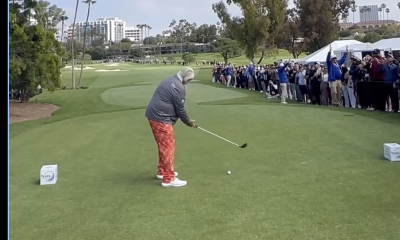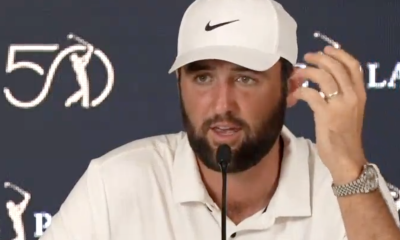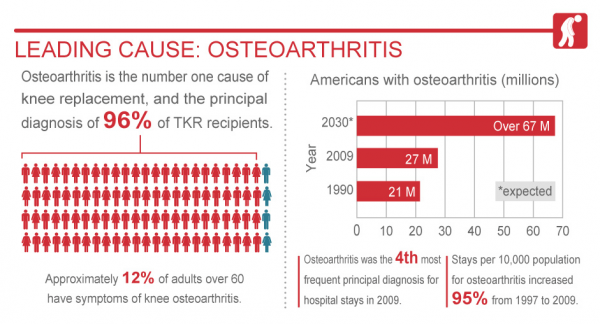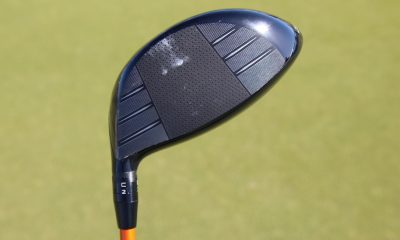Opinion & Analysis
Golfers benefit from new knee replacement technology

Last fall, my father-in-law joined the more than 650,000 total knee replacement patients of 2013[1]. He is a long-time golfer and had been struggling to play due to his moderate to severe knee pain for several years. Finally, the pain was too much to handle and he decided it was time for a knee replacement.
The most common reason golfers have knee replacement surgery is due to osteoarthritis. This is a mechanical condition where the “cushion” of the knee, called cartilage, wears out and the bone rubs against the bone with movement. Osteoarthritis can be very painful and highly agitated by the action of the golf swing.
Despite major advance and modern technology, Jim was one of the growing number of patients that would describe his experience as “traumatic” and “highly disappointing.” Enduring months of severe pain, a revision surgery and still being unable to return to golf after eight months, Jim is now struggling with the decision of whether or not to have his other knee replaced. Is it worth it?
Studies have shown that between 14 and 39 percent of people who have had a knee replacement are “dissatisfied” with their implant or reported “results below their expectations.” (Noble, P et al., Bourne, R et al., Scott, C et al.)
With the demand for total knee replacements expected to rise by 673 percent by the year 2030[2], it is highly likely that you or someone you know will soon be considering your surgical options.
Will you be able to return to an active lifestyle that includes pain free golf or will you be one of the 54,000 U.S. patients needing additional surgery for revisions?
Fortunately for us, science and technology continue to advance and we can now benefit from a major breakthrough in knee replacements. I recently had the pleasure to interview Dr. Gregory Martin. Dr. Martin is a board certified orthopaedic surgeon who specializes in hip and knee arthritis and other painful disorders and is one of a growing number of surgeons who traded in the traditional total knee protocol in favor of a fully customizable procedure through Conformis Customized Knee Replacements.
Q&A with Martin
In the past, a “custom fit knee replacement” meant that the instruments for fitting the knee were custom for the patient but that the actual knee was an off-the-shelf implant that comes in only a few different sizes. How is Conformis different?
“It’s no different than the fit of a suit coming in a variety of sizes versus the precise fit of a custom suit. Only with a suit, being off in fit by a small amount may not matter, but with an implant, precision fit is critical. People come in all different shapes and sizes and Conformis believes so should their knee implants. Conformis is different because they make customized, individually made implants along with instrumentation specifically made for the patient that helps the surgeon put the implant in correct.
Also, the knee has three parts to it and sometimes they are not all damaged. With Conformis, because a CT SCAN is taken as part of the process, if the patient is found to have damage in only one part or two parts of the knee, then a customized partial knee can be made. Partial knees have had a resurgence in popularity because of the ease of recovery and improved satisfaction.
How can custom fit components make a difference in the outcomes for patients?
Although total knee replacement helps most people, studies show as many as 1 in 5 patients remain not satisfied with their outcome after surgery. Persistent pain after surgery is a major factor in these patients. We now know that implant size plays a significant role in causing persistent pain.
Studies have shown that if an implant is too big by just 3 millimeters, it can double the risk of persistent pain after knee surgery. By making the implants fit precisely, the hope is that we will see higher satisfaction rates, which is what I am seeing in my early data.
What differences can patients expect to experience during rehabilitation?
I have seen my customized knee patients recover in about half the usual time. What I am used to seeing at three months, I now see at six weeks. The patients have less swelling, improved range of motion and function sooner. Why? Because bleeding around the knee and swelling after total knee surgery makes rehabilitation painful and difficult.
With the customized knees, the instrumentation and surgical technique is less traumatic, less bone is removed, and all of the bone that is cut is covered with implant because the fit is precise. So what we see is significantly less bleeding and swelling. Blood transfusions that are fairly common with non-customized total knees (around 10 to 20 percent in most studies) are quite rare with customized total knees (1 percent or less).
Can patients expect a difference in time in regards to returning to normal daily activities? Returning to more active activities?
Return to daily activities varies from patient to patient, but as a whole, I would say that my customized knee patients generally recover much sooner. I typically can get the customized knee patients out of the hospital either the afternoon of surgery or after one night, versus two to four nights for my non-customized knee patients. I see a lot more people doing activities that they enjoy at six weeks after surgery than I ever saw before.
One patient, who I recently saw at his six-week follow up, comes to mind. He had a non-customized knee I did a few years ago and he did well but took him at least three months to get back to a normal life. When I did his other knee with the Customized implant and saw him back at his six week follow up, he had just got back from a cruise and was dancing with his wife and happier than ever.
For partial knee patients, I have seen many golfing at four to six weeks and total knees at six to eight weeks. This level of activity would be unusual this early for my non-customized knee patients.
What are the advantages of choosing a Conformis custom knee replacement over an off-the-shelf replacement, specifically for golfers wanting to return to sport?
Although recovering quickly is important and we should always look for ways to get people better sooner, what really is more critical is the long-term outcome. Although many patients after total knee replacement are out of pain, they may not be able to do the things that they want to do like golf or other activities. They say the knee doesn’t feel right, it doesn’t feel like their knee.
The thought behind Conformis customized total knees is that by making the implant sized and shaped like the individuals own knee before it was damaged, the knee will feel more natural and allow people to resume more activities that they love to do.
Can you briefly talk about the technological advances that had to occur to allow for a process such as what Conformis is using to advance knee replacements?
Conformis was founded with the idea that modern technology and imaging techniques can be utilized to make better implants. A CT scan is taken to get precise pictures of the knee. The data in that scan is sent to the company and computer automated design (CAD) technology is used to map the knee and create an implant.
The instrumentation, which is all single use and disposable, is created on 3D printers (as opposed to traditional knee instruments which are re-used and must constantly go through re-sterilization). With Conformis, the entire kit is shipped to the hospital in a sterile box with the implant and the instruments. It is 21st Century technology at its best.
Is there anyway to know, prior to surgery, if a person is a better candidate for a custom knee (anyway to know if an off-the-shelf knee would be difficult to fit perfectly)?
We know that people come in all different shapes and sizes on the outside, and their knees look just as different on the inside. Other implant companies have realized this over the years and have created gender specific implants and have increased the number of sizes available with their non-customized knees. However, this may help fit more patients, but will never fit all patients.
Only true customized technology can achieve a perfect fit. After talking with my patients and giving them choices of implants, invariably they wish to have a customized knee. But there are some patients where a customized knee is not appropriate at this time (eg. cases with severe deformities, damage to major knee ligaments, or loss of bony landmarks which would make recreating the knee difficult).
Is there any difference in cost to the consumer when compared to traditional total knee replacement procedure?
Typically in the United States, implant costs are negotiated and covered by the hospitals or insurance companies. Generally, with the exception of any related co-pays for the CT scan required, there are no additional costs to the patient receiving a customized knee implant.
If someone was interested in having a customized knee replacement with the Conformis knee, how should they proceed?
Visit www.myconformisknee.com to learn more about the technology, hear patient’s real experiences and utilize the “find a doctor” feature to find a surgeon using the technology
If patients are interested in your service, what is the best way to contact you or your office?
My practice is in Palm Beach County, Fla., and my information can be found at www.floridajointreplacement.com
——————————————————-
In conclusion, the overall success rate of total knee replacements are good. But in my years of physical therapy, I have experienced both the good and the bad. If you are considering a total knee replacement, we have found that the success of the surgery is largely dependent on two factors: the quality of the product and the skill of the surgeon.
As a result, the advice that I always give to golfers considering knee replacement is this:
- Visit www.myconformisknee.com to find surgeons in your area using this technology.
- Get surgeon referrals from two to three local physical therapists who treat patients recovering from total knee replacements. Physical therapists have extensive experience treating the patients of local surgeons and will know which ones have the best results.
If you have any questions or comments, please respond below and we will be happy to respond.
[1] Knee Replacement Statistics: http://www.healthline.com/health/total-knee-replacement-surgery/statistics-infographic
[2] Arthritis Related Statistics CDC: http://www.cdc.gov/arthritis/data_statistics/arthritis_related_stats.htm
- LIKE3
- LEGIT0
- WOW1
- LOL0
- IDHT0
- FLOP0
- OB0
- SHANK1
Instruction
The Wedge Guy: The easiest-to-learn golf basic

My golf learning began with this simple fact – if you don’t have a fundamentally sound hold on the golf club, it is practically impossible for your body to execute a fundamentally sound golf swing. I’m still a big believer that the golf swing is much easier to execute if you begin with the proper hold on the club.
As you might imagine, I come into contact with hundreds of golfers of all skill levels. And it is very rare to see a good player with a bad hold on the golf club. There are some exceptions, for sure, but they are very few and very far between, and they typically have beat so many balls with their poor grip that they’ve found a way to work around it.
The reality of biophysics is that the body moves only in certain ways – and the particulars of the way you hold the golf club can totally prevent a sound swing motion that allows the club to release properly through the impact zone. The wonderful thing is that anyone can learn how to put a fundamentally sound hold on the golf club, and you can practice it anywhere your hands are not otherwise engaged, like watching TV or just sitting and relaxing.
Whether you prefer an overlap, interlock or full-finger (not baseball!) grip on the club, the same fundamentals apply. Here are the major grip faults I see most often, in the order of the frequency:
Mis-aligned hands
By this I mean that the palms of the two hands are not parallel to each other. Too many golfers have a weak left hand and strong right, or vice versa. The easiest way to learn how to hold the club with your palms aligned properly is to grip a plain wooden ruler or yardstick. It forces the hands to align properly and shows you how that feels. If you grip and re-grip a yardstick several times, then grip a club, you’ll see that the learning curve is almost immediate.
The position of the grip in the upper/left hand
I also observe many golfers who have the butt of the grip too far into the heel pad of the upper hand (the left hand for right-handed players). It’s amazing how much easier it is to release the club through the ball if even 1/4-1/2″ of the butt is beyond the left heel pad. Try this yourself to see what I mean. Swing the club freely with just your left hand and notice the difference in its release from when you hold it at the end of the grip, versus gripping down even a half inch.
To help you really understand how this works, go to the range and hit shots with your five-iron gripped down a full inch to make the club the same length as your seven-iron. You will probably see an amazing shot shape difference, and likely not see as much distance loss as you would expect.
Too much lower (right) hand on the club
It seems like almost all golfers of 8-10 handicap or higher have the club too far into the palm of the lower hand, because that feels “good” if you are trying to control the path of the clubhead to the ball. But the golf swing is not an effort to hit at the ball – it is a swing of the club. The proper hold on the club has the grip underneath the pad at the base of the fingers. This will likely feel “weak” to you — like you cannot control the club like that. EXACTLY. You should not be trying to control the club with your lower/master hand.
Gripping too tightly
Nearly all golfers hold the club too tightly, which tenses up the forearms and prevents a proper release of the club through impact. In order for the club to move back and through properly, you must feel that the club is controlled by the last three fingers of the upper hand, and the middle two fingers of the lower hand. If you engage your thumbs and forefingers in “holding” the club, the result will almost always be a grip that is too tight. Try this for yourself. Hold the club in your upper hand only, and squeeze firmly with just the last three fingers, with the forefinger and thumb off the club entirely. You have good control, but your forearms are not tense. Then begin to squeeze down with your thumb and forefinger and observe the tensing of the entire forearm. This is the way we are made, so the key to preventing tenseness in the arms is to hold the club very lightly with the “pinchers” — the thumbs and forefingers.
So, those are what I believe are the four fundamentals of a good grip. Anyone can learn them in their home or office very quickly. There is no easier way to improve your ball striking consistency and add distance than giving more attention to the way you hold the golf club.
More from the Wedge Guy
- The Wedge Guy: Golf mastery begins with your wedge game
- The Wedge Guy: Why golf is 20 times harder than brain surgery
- The Wedge Guy: Musings on the golf ball rollback
- LIKE83
- LEGIT13
- WOW5
- LOL1
- IDHT0
- FLOP4
- OB1
- SHANK8
19th Hole
Vincenzi’s 2024 Texas Children’s Houston Open betting preview

As the Florida swing comes to an end, the PGA Tour makes its way to Houston to play the Texas Children’s Houston Open at Memorial Park Golf Course.
This will be the fourth year that Memorial Park Golf Course will serve as the tournament host. The event did not take place in 2023, but the course hosted the event in 2020, 2021 and 2022.
Memorial Park is a par-70 layout measuring 7,432 yards and features Bermudagrass greens. Historically, the main defense for the course has been thick rough along the fairways and tightly mown runoff areas around the greens. Memorial Park has a unique setup that features three Par 5’s and five Par 3’s.
The field will consist of 132 players, with the top 65 and ties making the cut. There are some big names making the trip to Houston, including Scottie Scheffler, Wyndham Clark, Tony Finau, Will Zalatoris and Sahith Theegala.
Past Winners at Memorial Park
- 2022: Tony Finau (-16)
- 2021: Jason Kokrak (-10)
- 2020: Carlos Ortiz (-13)
In this article and going forward, I’ll be using the Rabbit Hole by Betsperts Golf data engine to develop my custom model. If you want to build your own model or check out all of the detailed stats, you can sign up using promo code: MATTVIN for 25% off any subscription package (yearly is best value).
Key Stats For Memorial Park
Let’s take a look at several metrics for Memorial Park to determine which golfers boast top marks in each category over their last 24 rounds:
Strokes Gained: Approach
Memorial Park is a pretty tough golf course. Golfers are penalized for missing greens and face some difficult up and downs to save par. Approach will be key.
Total Strokes Gained: Approach per round in past 24 rounds:
- Tom Hoge (+1.30)
- Scottie Scheffler (+1.26)
- Keith Mitchell (+0.97)
- Tony Finau (+0.92)
- Jake Knapp (+0.84)
Strokes Gained: Off the Tee
Memorial Park is a long golf course with rough that can be penal. Therefore, a combination of distance and accuracy is the best metric.
Total Strokes Gained: Off the Tee per round in past 24 rounds:
- Scottie Scheffler (+0.94)
- Kevin Dougherty (+0.93)
- Cameron Champ (+0.86)
- Rafael Campos (+0.84)
- Si Woo Kim (+0.70)
Strokes Gained Putting: Bermudagrass + Fast
The Bermudagrass greens played fairly fast the past few years in Houston. Jason Kokrak gained 8.7 strokes putting on his way to victory in 2021 and Tony Finau gained in 7.8 in 2022.
Total Strokes Gained Putting (Bermudagrass) per round past 24 rounds (min. 8 rounds):
- Adam Svensson (+1.27)
- Harry Hall (+1.01)
- Martin Trainer (+0.94)
- Taylor Montgomery (+0.88)
- S.H. Kim (+0.86)
Strokes Gained: Around the Green
With firm and undulating putting surfaces, holding the green on approach shots may prove to be a challenge. Memorial Park has many tightly mowed runoff areas, so golfers will have challenging up-and-down’s around the greens. Carlos Ortiz gained 5.7 strokes around the green on the way to victory in 2020.
Total Strokes Gained: Around the Green per round in past 24 rounds:
- Mackenzie Hughes (+0.76)
- S.H. Kim (+0.68)
- Scottie Scheffler (+0.64)
- Jorge Campillo (+0.62)
- Jason Day (+0.60)
Strokes Gained: Long and Difficult
Memorial Park is a long and difficult golf course. This statistic will incorporate players who’ve had success on these types of tracks in the past.
Total Strokes Gained: Long and Difficult in past 24 rounds:
- Scottie Scheffler (+2.45)
- Ben Griffin (+1.75)
- Will Zalatoris (+1.73)
- Ben Taylor (+1.53)
- Tony Finau (+1.42)
Course History
Here are the players who have performed the most consistently at Memorial Park.
Strokes Gained Total at Memorial Park past 12 rounds:
- Tyson Alexander (+3.65)
- Ben Taylor (+3.40)
- Tony Finau (+2.37)
- Joel Dahmen (+2.25)
- Patton Kizzire (+2.16)
Statistical Model
Below, I’ve reported overall model rankings using a combination of the five key statistical categories previously discussed.
These rankings are comprised of SG: App (24%) SG: OTT (24%); SG: Putting Bermudagrass/Fast (13%); SG: Long and Difficult (13%); SG: ARG (13%) and Course History (13%)
- Scottie Scheffler
- Wyndham Clark
- Tony Finau
- Joel Dahmen
- Stephan Jaeger
- Aaron Rai
- Sahith Theegala
- Keith Mitchell
- Jhonnatan Vegas
- Jason Day
- Kurt Kitayama
- Alex Noren
- Will Zalatoris
- Si Woo Kim
- Adam Long
2024 Texas Children’s Houston Open Picks
Will Zalatoris +2000 (Caesars)
Scottie Scheffler will undoubtedly be difficult to beat this week, so I’m starting my card with someone who I believe has the talent to beat him if he doesn’t have his best stuff.
Will Zalatoris missed the cut at the PLAYERS, but still managed to gain strokes on approach while doing so. In an unpredictable event with extreme variance, I don’t believe it would be wise to discount Zalatoris based on that performance. Prior to The PLAYERS, the 27-year-old finished T13, T2 and T4 in his previous three starts.
Zalatoris plays his best golf on long and difficult golf courses. In his past 24 rounds, he ranks 3rd in the category, but the eye test also tells a similar story. He’s contended at major championships and elevated events in the best of fields with tough scoring conditions. The Texas resident should be a perfect fit at Memorial Park Golf Club.
Alex Noren +4500 (FanDuel)
Alex Noren has been quietly playing some of his best golf of the last half decade this season. The 41-year-old is coming off back-to-back top-20 finishes in Florida including a T9 at The PLAYERS in his most recent start.
In his past 24 rounds, Noren ranks 21st in the field in Strokes Gained: Off the Tee, 30th in Strokes Gained: Around the Green, 25th in Strokes Gained: Total on long and difficult courses and 21st in Strokes Gained: Putting on fast Bermudagrass greens.
In addition to his strong recent play, the Swede also has played well at Memorial Park. In 2022, Noren finished T4 at the event, gaining 2.2 strokes off the tee and 7.0 strokes on approach for the week. In his two starts at the course, he’s gained an average of .6 strokes per round on the field, indicating he is comfortable on these greens.
Noren has been due for a win for what feels like an eternity, but Memorial Park may be the course that suits him well enough for him to finally get his elusive first PGA Tour victory.
Mackenzie Hughes +8000 (FanDuel)
Mackenzie Hughes found himself deep into contention at last week’s Valspar Championship before faltering late and finishing in a tie for 3rd place. While he would have loved to win the event, it’s hard to see the performance as anything other than an overwhelming positive sign for the Canadian.
Hughes has played great golf at Memorial Park in the past. He finished T7 in 2020, T29 in 2021 and T16 in 2022. The course fit seems to be quite strong for Hughes. He’s added distance off the tee in the past year or and ranks 8th in the field for apex height, which will be a key factor when hitting into Memorial Park’s elevated greens with steep run-off areas.
In his past 24 rounds, Hughes is the best player in the field in Strokes Gained: Around the Greens. The ability to scramble at this course will be extremely important. I believe Hughes can build off of his strong finish last week and contend once again to cement himself as a President’s Cup consideration.
Akshay Bhatia +8000 (FanDuel)
Akshay Bhatia played well last week at the Valspar and seemed to be in total control of his golf ball. He finished in a tie for 17th and shot an impressive -3 on a difficult Sunday. After struggling Thursday, Akshay shot 68-70-68 in his next three rounds.
Thus far, Bhatia has played better at easier courses, but his success at Copperhead may be due to his game maturing. The 22-year-old has enormous potential and the raw talent to be one of the best players in the world when he figures it all out.
Bhatia is a high upside play with superstar qualities and may just take the leap forward to the next stage of his career in the coming months.
Cameron Champ +12000 (FanDuel)
Cameron Champ is a player I often target in the outright betting market due to his “boom-or-bust” nature. It’s hard to think of a player in recent history with three PGA Tour wins who’s been as inconsistent as Champ has over the course of his career.
Despite the erratic play, Cam Champ simply knows how to win. He’s won in 2018, 2019 and 2021, so I feel he’s due for a win at some point this season. The former Texas A&M product should be comfortable in Texas and last week he showed us that his game is in a pretty decent spot.
Over his past 24 rounds, Champ ranks 3rd in Strokes Gained: Off the Tee and 30th in Strokes Gained: Total on long and difficult courses. Given his ability to spike at any given time, Memorial Park is a good golf course to target Champ on at triple digit odds.
Robert MacIntyre +12000 (FanDuel)
The challenge this week is finding players who can possibly beat Scottie Scheffler while also not dumping an enormous amount of money into an event that has a player at the top that looks extremely dangerous. Enter McIntyre, who’s another boom-or-bust type player who has the ceiling to compete with anyone when his game is clicking on all cylinders.
In his past 24 rounds, MacIntyre ranks 16th in the field in Strokes Gained: Off the Tee, 17th in Strokes Gained: Around the Green and 10th in Strokes Gained: Total on long and difficult courses.
MacIntyre’s PGA Tour season has gotten off to a slow start, but he finished T6 in Mexico, which is a course where players will hit driver on the majority of their tee shots, which is what we will see at Memorial Park. Texas can also get quite windy, which should suit MacIntyre. Last July, the Scot went toe to toe with Rory McIlroy at the Scottish Open before a narrow defeat. It would take a similar heroic effort to compete with Scheffler this year in Houston.
Ryan Moore +15000 (FanDuel)
Ryan Moore’s iron play has been absolutely unconscious over his past few starts. At The PLAYERS Championship in a loaded field, he gained 6.1 strokes on approach and last week at Copperhead, he gained 9.0 strokes on approach.
It’s been a rough handful of years on Tour for the 41-year-old, but he is still a five-time winner on the PGA Tour who’s young enough for a career resurgence. Moore has chronic deterioration in a costovertebral joint that connects the rib to the spine, but has been getting more consistent of late, which is hopefully a sign that he is getting healthy.
Veterans have been contending in 2024 and I believe taking a flier on a proven Tour play who’s shown signs of life is a wise move at Memorial Park.
- LIKE15
- LEGIT1
- WOW1
- LOL0
- IDHT0
- FLOP0
- OB0
- SHANK2
Opinion & Analysis
Ryan: Why the race to get better at golf might be doing more harm than good

B.F. Skinner was one of the most important psychologists of the 20th century, developing the foundation of the development of reinforcement, and in doing so, creating the concept of behaviorism. In simple terms, this means that we are conditioned by our habits. In practical terms, it explains the divide between the few and far between elite instructors and college coaches.
To understand the application, let’s quickly review one of B.F. Skinner’s most important experiments; superstitions in the formation of behavior by pigeons. In this experiment, food was dispensed to pigeons at random intervals. Soon, according to Skinner, the pigeons began to associate whatever action they were doing at the time of the food being dispensed. According to Skinner, this conditioned that response and soon, they simply haphazardly repeated the action, failing to distinguish between cause and correlation (and in the meantime, looking really funny!).
Now, this is simply the best way to describe the actions of most every women’s college golf coach and too many instructors in America. They see something work, get positive feedback and then become conditioned to give the feedback, more and more, regardless of if it works (this is also why tips from your buddies never work!).
Go to a college event, particularly a women’s one, and you will see coaches running all over the place. Like the pigeons in the experiment, they have been conditioned into a codependent relationship with their players in which they believe their words and actions, can transform a round of golf. It is simply hilarious while being equally perturbing
In junior golf, it’s everywhere. Junior golf academies make a living selling parents that a hysterical coach and over-coaching are essential ingredients in your child’s success.
Let’s be clear, no one of any intellect has any real interest in golf — because it’s not that interesting. The people left, including most coaches and instructors, carve out a small fiefdom, usually on the corner of the range, where they use the illusion of competency to pray on people. In simple terms, they baffle people with the bullshit of pseudo-science that they can make you better, after just one more lesson.
The reality is that life is an impromptu game. The world of golf, business, and school have a message that the goal is being right. This, of course, is bad advice, being right in your own mind is easy, trying to push your ideas on others is hard. As a result, it is not surprising that the divorce rate among golf professionals and their instructors is 100 percent. The transfer rate among college players continues to soar, and too many courses have a guy peddling nefarious science to good people. In fact, we do at my course!
The question is, what impact does all this have on college-age and younger kids? At this point, we honestly don’t know. However, I am going to go out on a limb and say it isn’t good.
Soren Kierkegaard once quipped “I saw it for what it is, and I laughed.” The actions of most coaches and instructors in America are laughable. The problem is that I am not laughing because they are doing damage to kids, as well as driving good people away from this game.
The fact is that golfers don’t need more tips, secrets, or lessons. They need to be presented with a better understanding of the key elements of golf. With this understanding, they can then start to frame which information makes sense and what doesn’t. This will emancipate them and allow them to take charge of their own development.
- LIKE14
- LEGIT5
- WOW1
- LOL2
- IDHT0
- FLOP1
- OB0
- SHANK11
-

 19th Hole2 weeks ago
19th Hole2 weeks agoJohn Daly stuns fans into silence with brutal opening tee shot on PGA Tour Champions
-

 19th Hole6 days ago
19th Hole6 days agoThings got heated at the Houston Open between Tony Finau and Alejandro Tosti. Here’s why
-

 19th Hole3 days ago
19th Hole3 days agoReport: Tiger Woods has ‘eliminated sex’ in preparation for the 2024 Masters
-

 19th Hole2 weeks ago
19th Hole2 weeks ago2-time major champ announces shock retirement from the sport at age of 33
-

 19th Hole3 weeks ago
19th Hole3 weeks agoEdoardo Molinari reveals the latest PGA Tour golfer to turn down ‘good offer’ from LIV Golf
-

 19th Hole2 weeks ago
19th Hole2 weeks agoCharlie Woods finds it tough going on American Junior Golf Association debut
-

 19th Hole3 weeks ago
19th Hole3 weeks agoScottie Scheffler had an interesting response when asked how he ‘quiets the noise’ following Players victory
-

 19th Hole5 days ago
19th Hole5 days agoAddiction, spinal fusion, and scam artists – Everything Anthony Kim revealed in candid interview with David Feherty






















ROBERT
Mar 30, 2016 at 5:44 pm
I went thru a four year period getting uflexxa shots before i knew the only solution to getting back to great golf again was a PKR. I consulted six doctors. I had done my research and knew i only needed a Partial. but the first four doctors i went to tried talking me into a full replacement. Witha full they cut your ACL, MDL and remove your PCL. It will always feel artificial and the recovery is brutal. I was golfing after six weeks. I had a lateral PKR on my right knee-i was bone to bone from a torn worn down menicus. I know have a perfect working right knee that i can “load’ into again and have regained 20 plus yards on my drives and 10 MPH on my swing speed. I hope to regain my scratch hdcp soon.
Pingback: In the News | The Joint Replacement Center of Scottsdale
Patrick
Jul 2, 2014 at 8:44 pm
I have had my right knee and left hip replacement. First was my left hip due to a sports injury. I had to donate blood and took a couple of shots of EPO prior to surgery . Great surgeon but having been a professional athlete I was very disciplined on recovery and rehab. My initial goal was to walk without limping. Next was my right knee.
This was number five on the right knee due to a botched initial surgery 30 years ago. Subsequent surgeries were for cartilage remove and then the dreaded night tibial osteotomy.
So honestly both surgeries took the better part of five years to be mostly pain free and more importantly, I could walk and golf without pain.
My advice for those considering either, lose weight and do exactly what the surgeon says. Look at this as an opportunity to get your mobility back. Surgeons are very good these days and want you to do well.
Jim
Jun 30, 2014 at 3:58 pm
I’ve had both my knees replaced and am playing as well as I ever have. First, as Nat said, find a good surgeon. I did and I talked to several before choosing. I’ve had no complications at all. Also I agree with Nat that doing your rehab is VITAL. This means at HOME as well as the therapy center. You have to do most rehab on your own. I have good old standard knee replacements but with the modern liners to last longer. My doctor fitting them perfectly and I too was back hitting balls with wedges in about 6 weeks.
Nat
Jun 29, 2014 at 9:31 am
I had TKR in November, was back hitting balls in 6 weeks, walking 18 in 3-4 months. I was 50, had no cartilage in my knee since 20 due to college sports injury. This is the best thing I’ve ever done. I am back to elliptical 1 hr a day and golf, typically walking. I won’t lie….it was a hard recovery, but I was extremely diligent with my therapy and stretching. My advice: be in best shape you can be prior to surgery; be prepared to be in pain and work very hard in rehab. It only lasts 3-6 weeks, but the pain is there. Not ouch pain, just generalized discomfort; last, donate blood ahead of time. You lose a lot, and you’ll likely needed a transfusion.
Also, you do not need a custom knee. That is a gimmick. You need a skilled surgeon who does a lot, a great physical therapist, and a caring spouse.
Pingback: Golfers benefit from new knee replacement technology | Spacetimeandi.com
Pingback: Golfers benefit from new knee replacement technology - I'd Rather Be Golfing